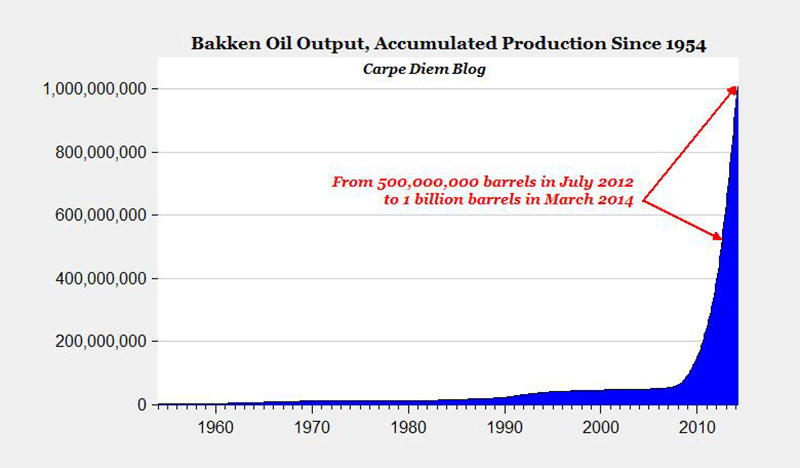Late in 2013 the US Energy Information Administration (EIA) estimated crude oil production in the Bakken region of North Dakota and Montana would top 1 MMbopd. This meant that, at that time, the Bakken region contributed a little over 10% of total US oil production and became the fourth region (along with the Gulf of Mexico, Eagle Ford and the Permian Basin) producing more than 1 MMbopd in the country. At the same time, infrastructure improvements in the central part of the USA have allowed for more of this oil to reach central refineries, narrowing the price differential between Bakken and West Texas Intermediate crudes.
 Map of North America, showing distribution of major Shale Plays. Source: EIANow, the largest leaseholder and producer in the Bakken shale play – independent oil producer Continental Resources, based in Oklahoma City – has announced that the Bakken of North Dakota and Montana recently reached the milestone of producing a billion barrels of the light, sweet crude oil. According to Continental, data from IHS show that the Bakken’s cumulative oil production reached this landmark in the first quarter of 2014.
Map of North America, showing distribution of major Shale Plays. Source: EIANow, the largest leaseholder and producer in the Bakken shale play – independent oil producer Continental Resources, based in Oklahoma City – has announced that the Bakken of North Dakota and Montana recently reached the milestone of producing a billion barrels of the light, sweet crude oil. According to Continental, data from IHS show that the Bakken’s cumulative oil production reached this landmark in the first quarter of 2014.
“This milestone validates the immense potential of the Bakken field, and development is just beginning,” said Jack Stark, Senior Vice President of Exploration for Continental. Going on to illustrate the remarkable ramp-up in production, Stark said, “Two-thirds of this oil was produced in the last three years. This is something our country can celebrate as the oil and natural gas industry continues to create jobs, grow our economy and secure America’s energy future.”
Rapid Development
Confirmation of the billion- barrel-milestone came with the publication of data showing that North Dakota has generated 852 MMb of Bakken crude, and Montana has produced about 151 MMb through to the first quarter of 2014. The remarkable speed of development has been possible due to the use of the widely publicised techniques of horizontal drilling and hydraulic fracturing, designed to recover the oil trapped in a thin layer of dense rock over three kilometres beneath the surface.
 Chart showing that production in the Bakken shale formation in western North Dakota and eastern Montana has now exceeded 1 billion barrels of crude and half of that oil has been produced in less than 2 years. Source: Mark J. Perry, April 30, 2014.The Bakken encompasses some 65,000 km2 in North Dakota, Montana, Saskatchewan and Manitoba with about two-thirds of the acreage in western North Dakota. Development and production have evolved at a rapid pace, as summarised by Thomas Smith in his excellent 2012 article in GEO ExPro Vol.9,No.1. For example, in 2007 North Dakota produced 12,000 bopd (303 wells), rising to 106,000 bopd by 2009 (904 wells) and by 2012 was producing 443,425 bopd (3,118 wells), before reaching the 1 MMbopd landmark in 2013.
Chart showing that production in the Bakken shale formation in western North Dakota and eastern Montana has now exceeded 1 billion barrels of crude and half of that oil has been produced in less than 2 years. Source: Mark J. Perry, April 30, 2014.The Bakken encompasses some 65,000 km2 in North Dakota, Montana, Saskatchewan and Manitoba with about two-thirds of the acreage in western North Dakota. Development and production have evolved at a rapid pace, as summarised by Thomas Smith in his excellent 2012 article in GEO ExPro Vol.9,No.1. For example, in 2007 North Dakota produced 12,000 bopd (303 wells), rising to 106,000 bopd by 2009 (904 wells) and by 2012 was producing 443,425 bopd (3,118 wells), before reaching the 1 MMbopd landmark in 2013.
And, as we have seen, North Dakota is not the only area with Bakken production, with neighbouring Montana, where the present oil boom originated (see GEO ExPro Vol. 7, No. 2), and Canada adding significant production of their own. Unlocking the rich resources of the Bakken shale have propelled North Dakota from the nation’s ninth-largest oil producer in 2006 to rank second in crude oil production in the United States, behind only Texas.
Devonian Formation
Deposited within the intracratonic Williston Basin, approximately 360 million years ago, the Bakken Formation is Devonian to Mississippian in age. The thickest portion of the Bakken (46m) is in north-western North Dakota and it thins evenly south-eastwards toward the margins of the Basin. The upper and lower members consist of hard, siliceous, black organic-rich shales. These form effective seals for the middle member, which consists of five highly variable lithologies, from several argillaceous siltstones to fine-grained sandstone and limestone, all with low primary permeability (0.04 mD average) and porosity (5% average). The other important reservoir target, the Three Forks Formation, consists of shales, dolostones, siltstones and sandstones with a maximum thickness of 76m.





